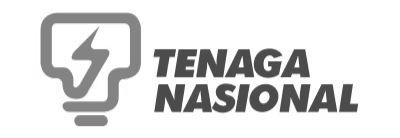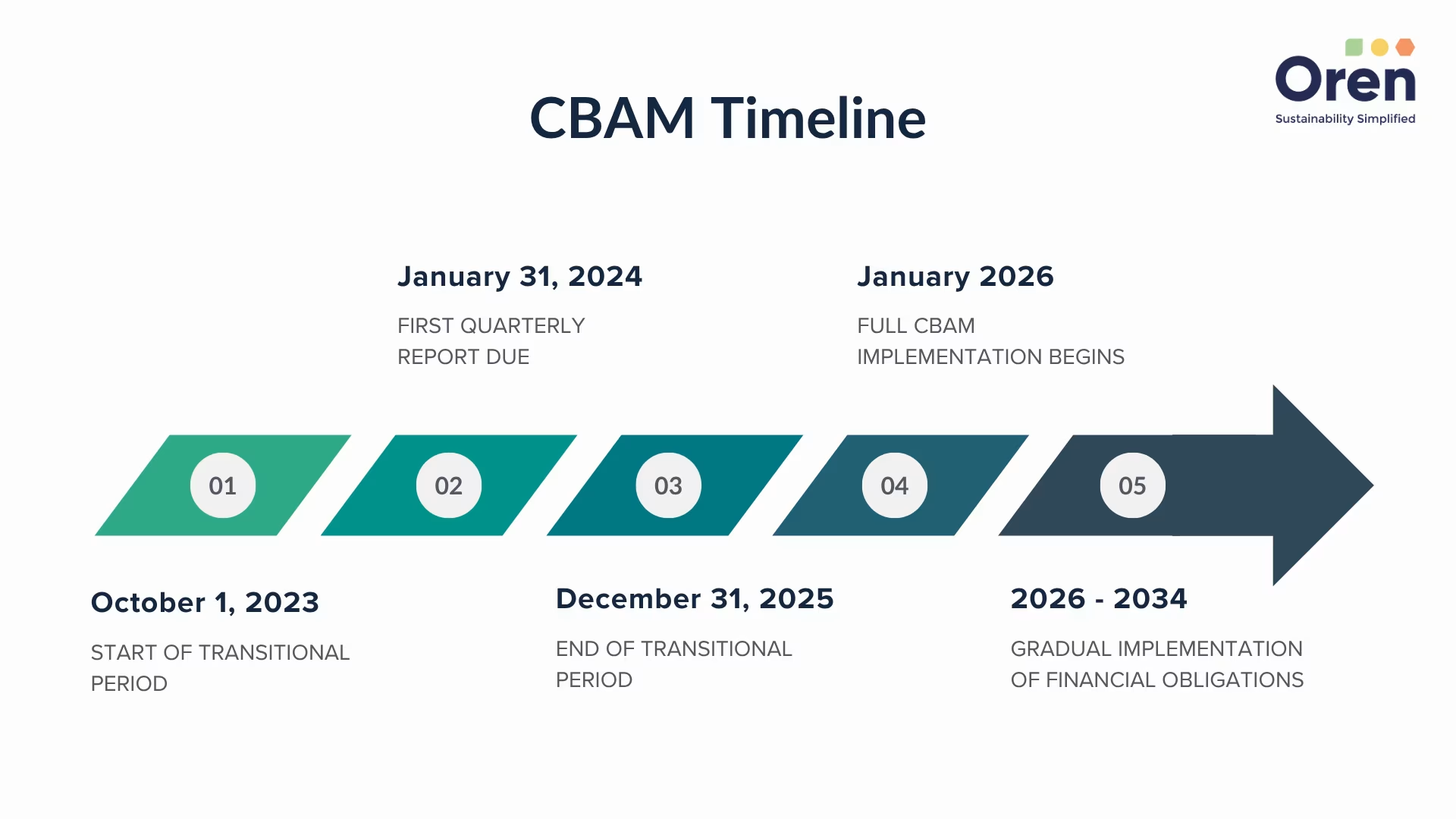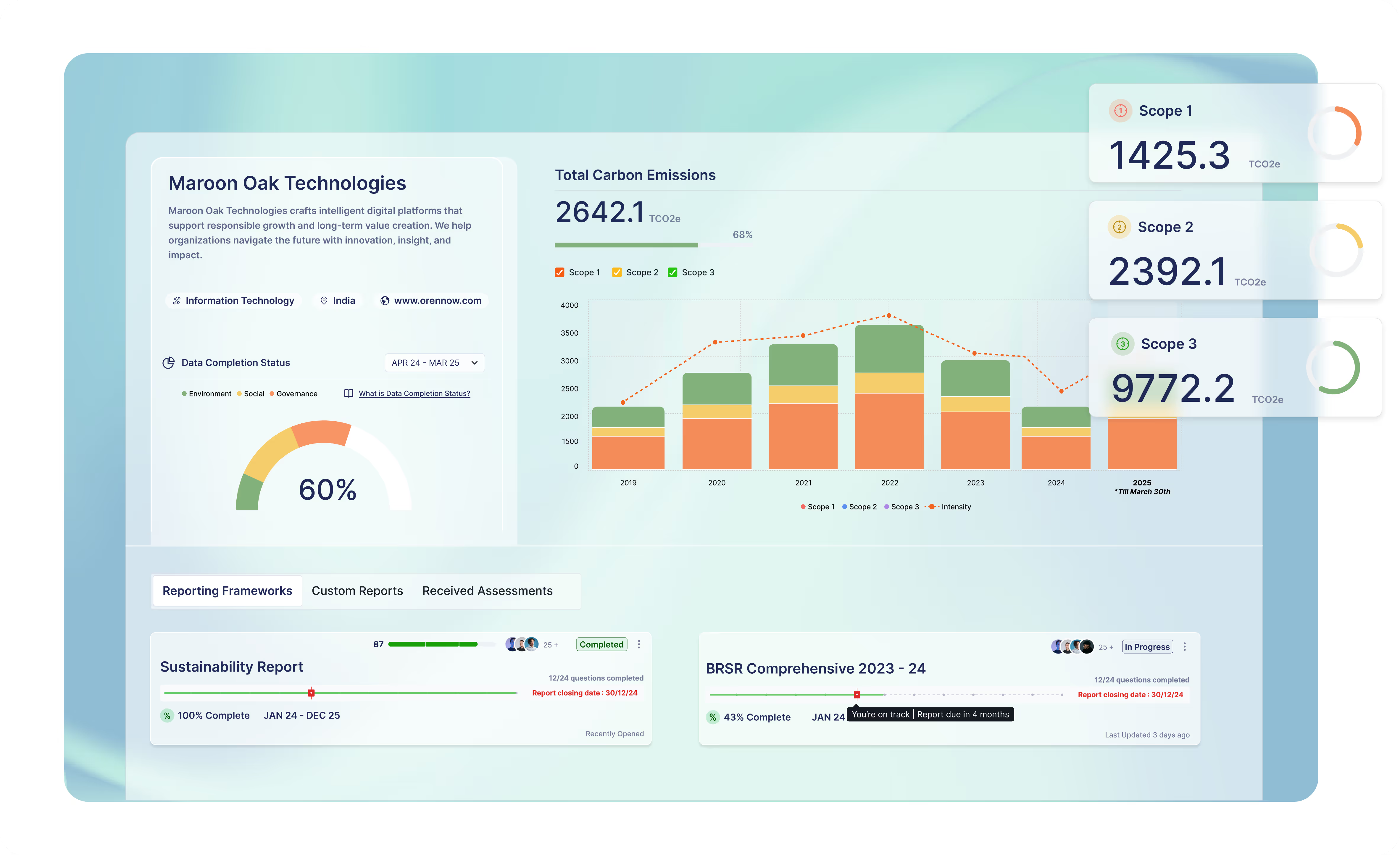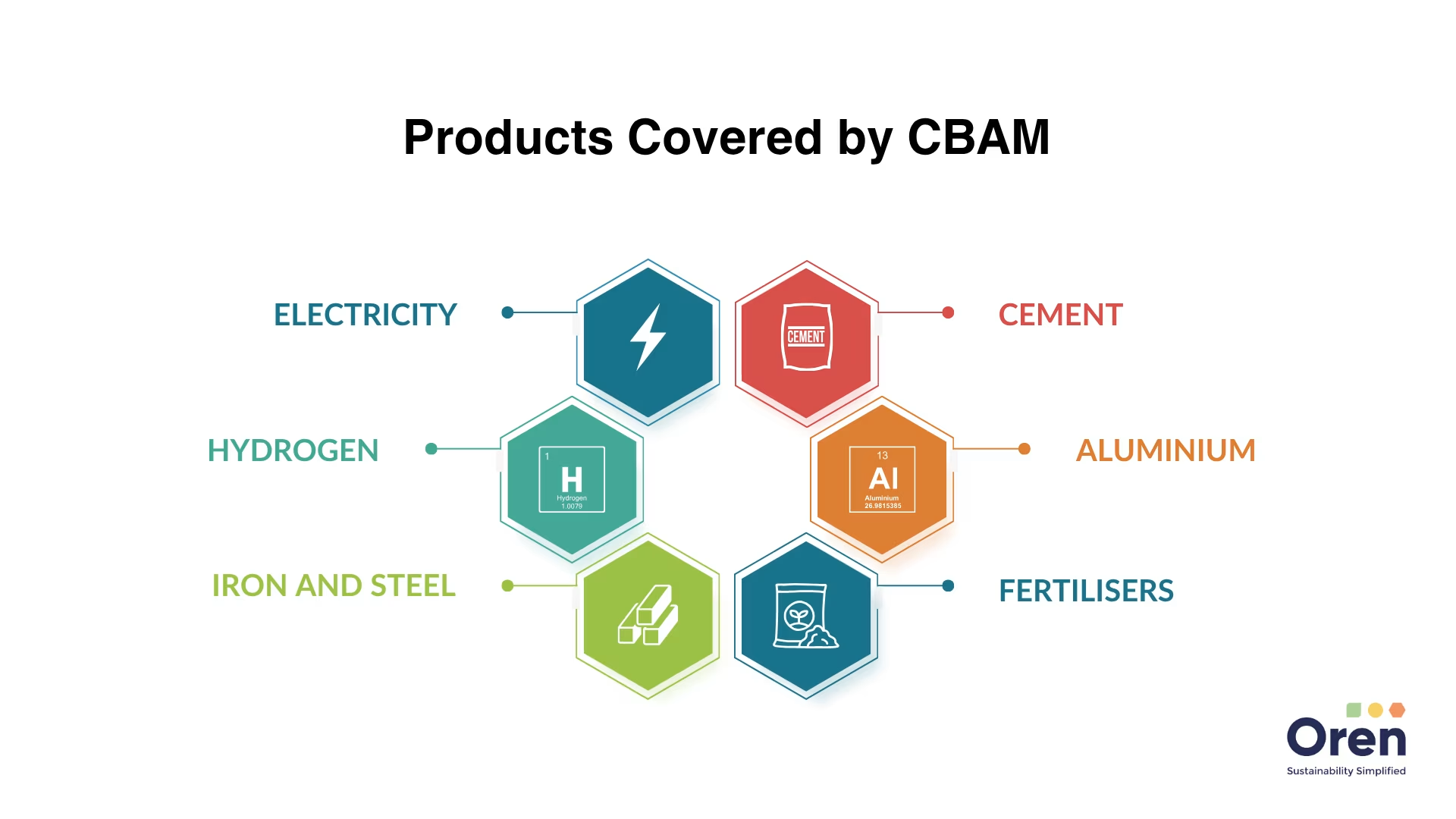


Accurate CBAM Reporting with Zero Hassle and Zero Delay
The Carbon Border Adjustment Mechanism (CBAM) is the European Union’s landmark climate policy designed to address carbon leakage by levelling the playing field between EU producers and their imports. It provides a structured framework for companies to measure, report, and account for the embedded carbon emissions in goods exported to the EU.
By complying with CBAM requirements, businesses can maintain market access to the EU, avoid potential penalties, and demonstrate leadership in low-carbon trade. The mechanism encourages companies to quantify their carbon footprint, adopt cleaner production methods, and integrate carbon considerations into their supply chain decisions.



.avif)







































What is CBAM & Why it Matters?
Definition
The Carbon Border Adjustment Mechanism (CBAM) policy was introduced by the European Union (EU) in October 2023. It places the import duty on the greenhouse gas (GHG) emissions in the production of selected imports. The industries currently covered under this policy include aluminium, cement, steel, fertilisers, electricity, and hydrogen.
Purpose
The CBAM policy is aimed at the prevention of ‘carbon leakage’ (when companies move production to countries with weaker climate rules and thus lower cost of production). This is how it ensures fair competition between EU and non-EU producers.
Business relevance
Companies outside the EU must comply with CBAM if they export the mentioned products, as EU importers are legally required to report emissions and buy CBAM certificates. High-emissions products will become costlier, thus making low-carbon producers more competitive.
How Does the CBAM Mechanism Work?
The process of CBAM involves the following aspects:
Import of Covered Goods
CBAM applies to imports of carbon-intensive goods such as cement, electricity, fertilisers, aluminium, steel, iron, and hydrogen. The imports from countries already in the EU ETS, such as Norway, Liechtenstein, Iceland, and Switzerland, are exempted.
Registration of Importers
The companies importing CBAM goods need to apply from January 1, 2025, to become Authorised CBAM Declarants. The restrictions will be imposed from January 1, 2026, allowing only registered declarants to import CBAM goods.
Reporting of Embedded Emissions
Importers need to submit quarterly CBAM reports showing the quantity of imports, direct and indirect embedded emissions, and any carbon price already paid in the country of origin.
These reports are mandatory but do not involve financial obligations at this stage. The submitted reports are further processed for data verification if actual values are used. They are verified by a certified testing body.
Purchase of CBAM Certificates
Importers must buy CBAM certificates that correspond to the amount of embedded carbon dioxide equivalent (CO2e) emissions in their imports. The price of each certificate mirrors the average EU ETS allowance price. Any carbon tax paid abroad is deducted to avoid double charging.
Annual CBAM Declaration and Reconciliation
By May 31st each year, authorised declarants must file an annual CBAM declaration showing imports and related emissions from the previous year. The declaration is compared against the number of certificates purchased. If too few certificates are acquired, financial sanctions could be imposed.
CBAM Reporting Requirements and Timeline
The CBAM is divided into two phases: the transitional phase and the definitive regime. While the first one deals with the reporting aspect, the second will be concerned with financial obligations. Here are the detailed insights into the two phases:
Transitional Phase (2023–2025): Key obligations for EU businesses
From October 2023 to the end of December 2025, the companies are obligated to report on their emissions. There are no financial obligations within the mentioned period. This time can be used by businesses to prepare for the definitive regime starting in 2026. It gives companies the opportunity to test reporting systems, collaborate with suppliers, and address data gaps before financial obligations and penalties apply. They can also prepare to become an Authorised CBAM Declarant if continuing imports into 2026.
Reporting obligations include:
- Quarterly report submission that covers direct emissions from imports
- Incorporate actual emissions data from producers, if available, or use equivalent or default methodologies
- Produce traceable data The reports must be filed by the end of the month after the quarter.
Definitive Regime (from 2026): The post-2026 landscape
This phase will involve stricter reporting, where the companies will be financially obligated. The importing companies will submit annual reports and purchase CBAM certificates to cover embedded emissions.
Here is what specifically the companies must do:
1. Annually submit the CBAM declaration for all the imports from the past year
2. Buy and hand over CBAM certificates equal to the emissions in those imports
3. Choose certificates based on the weekly EU ETS average
4. Deduct the already paid carbon costs
5. Get the emissions data verified by an independent body
Companies can choose between two methodologies to calculate emissions:
1. The calculation-based approach involves the calculation of emissions indirectly. It can be used:
- Activity data with emission factors: It can be used for tracking the amount of consumed fuel, electricity, or raw material and multiplying the value by standard factors. The result will be how much carbon dioxide each unit generates.
- Mass balance method: It compares the carbon content of all materials entering and leaving the production process to estimate how much carbon is released as emissions.
2. The measurement-based method is more direct. It measures the actual concentration of greenhouse gases and the volume of the flue gases released at the manufacturing site. This provides emissions data based on real-time monitoring rather than estimates.
Handle the reporting, certificates, and documents in the official registry
Before 2026, the companies must register as an authorised CBAM declarant with their national authority. They will need to plan their budget for buying certificates, collecting verified emissions data for each product, and ensuring suppliers can provide accurate information. Any delays, missing data, or mistakes could lead to higher costs or penalties.
Recent Updates
The EU proposed the Omnibus or Simplification Package in early 2025. These are a set of updates designed to streamline CBAM processes and support its proper implementation from 2026.
- 50 tonne exemption rule: Importers bringing in less than 50 tonnes of a CBAM product annually are exempt from reporting and certificates, but must track volumes.
- Simplified authorisation and digital portal: Becoming an authorised declarant is easier. Third parties can file for the companies, and all processes will run through a single EU CBAM portal.
- New deadlines for certificates and reports: Tracking begins in 2026, but the first certificates are due in 2027. The new deadlines for reports are 31 August and for certificates are 31 October.
- Narrowed emissions scope: CBAM now covers only direct emissions, including electricity use. The emissions do not cover steam, heat, and cooling to ease reporting.

Implications of CBAM
The implications of CBAM for importers are stated as follows:
1. Business-Level Impacts
Financial
Importers will face increased costs due to the requirement of CBAM certificate purchases. Thus, there will be a rise in product prices across sectors like aluminium, steel, and cement. Further, developing countries will also face significant costs to comply with CBAM when exporting to the EU. The economic impact on these countries could exceed the revenues generated by the CBAM, potentially causing financial strain.
Operational
Companies must adjust supply chains by working with suppliers who can provide verified emissions data, increasing contractual and compliance complexity. The businesses operating in developing countries may lack time, resources, and systems to align with the EU’s carbon pricing, thus creating operational difficulties.
Strategic
Importer firms will be pushed to accelerate low-carbon transitions, invest in greener technologies, and reorient sourcing toward suppliers with lower embedded emissions. Exporters may need to modernise production and adopt low-carbon technologies to remain competitive in the EU market. Other countries will also need to negotiate with the EU to secure fairer implementation and protect trade interests.
2. Risks of Non-Compliance
Penalties
Failure to submit accurate reports or surrender certificates on time can result in financial fines.
Market access
Persistent non-compliance could lead to restrictions or even loss of access to the EU market.
CBAM in the Context of Climate and ESG Regulations
CBAM is part of a broader climate and sustainability regulatory landscape. It does not operate in isolation and links directly with the EU Emissions Trading System (EU ETS). It ensures that imported products face similar carbon costs as domestic producers.
CBAM supports companies in meeting ESG reporting rules, like CSRD and GHG protocol. It eases the companies to include carbon compliance in their existing sustainability efforts. Moreover, it also prepares them for future global carbon pricing rules since similar systems may appear in other countries.
Imports like steel and aluminium will need CBAM certificates, and more products will be covered as free ETS allowances are phased out from 2026 to 2034. CBAM and ESG reporting will be easier due to the use of consistent methods such as GHG protocol standards, lifecycle assessments, and verified supplier data.
Go Beyond Reporting.
Start Driving Real Impact.
Testimonials

Watch the Video Testimonial

Atul Khanapurkar
Executive Director, Shriram Pistons & Rings

Watch the Video Testimonial

Vidhi Thukral
Senior Manager, Max Financial Services


Shalaka Ovalekar
Company Secretary and VP-Legal, ADF Foods
Frequently Asked Questions
The Carbon Border Adjustment Mechanism (CBAM) is a policy initiative by the European Union (EU) designed to place a carbon price on imports of certain goods. This mechanism ensures that imported products are subject to the same carbon costs as those produced within the EU, thereby preventing "carbon leakage," where companies might relocate production to countries with less stringent emissions regulations.
CBAM initially targets imports of specific carbon-intensive products, including:
- Steel and iron
- Aluminum
- Cement
- Fertilizers
- Electricity
These sectors are prioritised due to their significant carbon emissions during production.
The importing company in the European Union (EU) or its authorised indirect customer representatives are responsible for complying with CBAM. They must accurately report emissions embedded in imported goods, purchase the required CBAM certificates, ensure data verification, and coordinate with suppliers for relevant information.
Yes, non-EU companies with substantial activities in the EU are subject to the CSRD. Specifically, companies generating a net turnover of more than €150 million in the EU and having at least one subsidiary or branch in the EU meeting certain criteria will need to comply with the CSRD requirements.
Yes, to reduce administrative burdens, the EU has proposed exemptions for imports below certain thresholds. For instance, imports with a total value not exceeding €150 are exempted from CBAM obligations. Additionally, countries with carbon pricing mechanisms equivalent to the EU's may have adjusted obligations under CBAM.
The information essential for CBAM reporting includes:
- Type and quantity of imported goods
- Their Combined Nomenclature (CN) codes
- Country of origin
- Production facility
- Detailed production processes
If the information in CBAM reports is incorrect, the companies may face penalties, fines or other enforcement actions in the definitive phase.
Reporting declarants may face penalties ranging between EUR 10 and EUR 50 for each tonne of unreported emissions. The mentioned penalties apply if the reporting declarant either fails to submit a CBAM report or submits an incorrect/incomplete report and does not correct it after the competent authority requests amendments.
The EU CBAM uses certificates linked to the EU ETS. It covers electricity and limits indirect emissions to cement and fertilisers with annual reporting. The UK CBAM applies a direct tax and excludes electricity. It covers indirect emissions across all sectors and will begin annual reporting in 2027.
While the EU’s Carbon Border Adjustment Mechanism (CBAM) is referred to as a carbon pricing tool, the UK’s CBAM operates as a tax. The EU's CBAM works similarly to an import duty or tax on specific imported goods, requiring importers to purchase certificates to cover the carbon emissions embedded in certain imported goods.
Sustainability Simplified
Wherever you are in your sustainability journey, we help you advance with confidence.
Schedule a Call



.avif)


